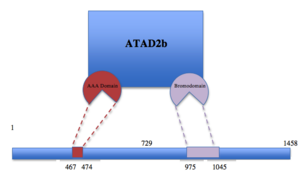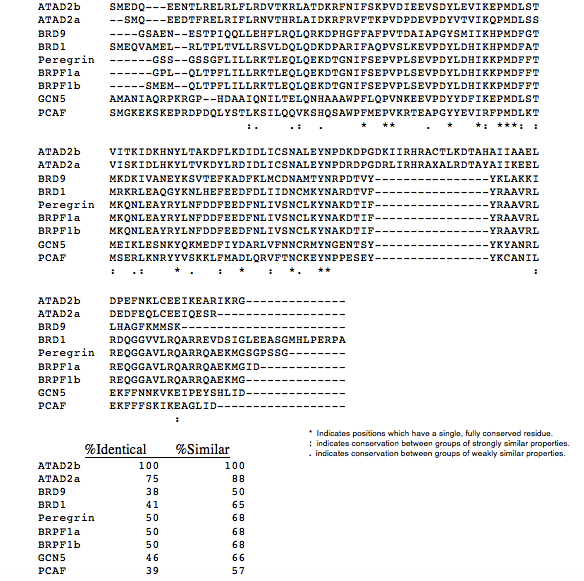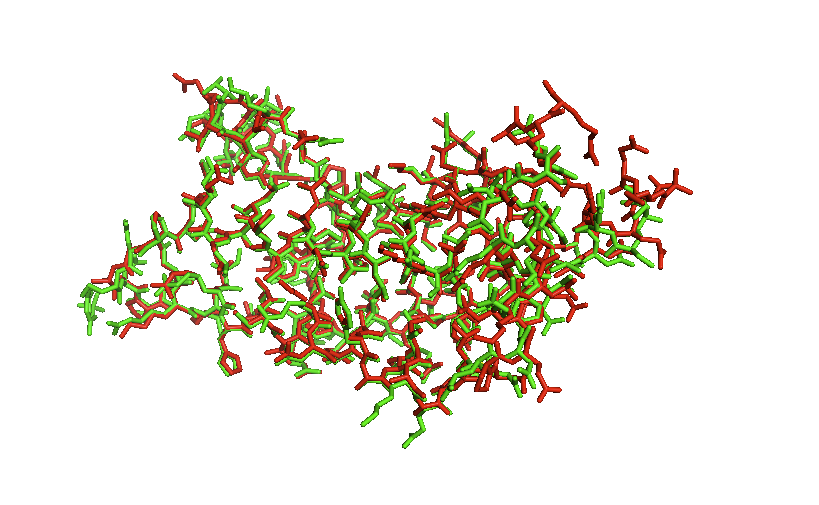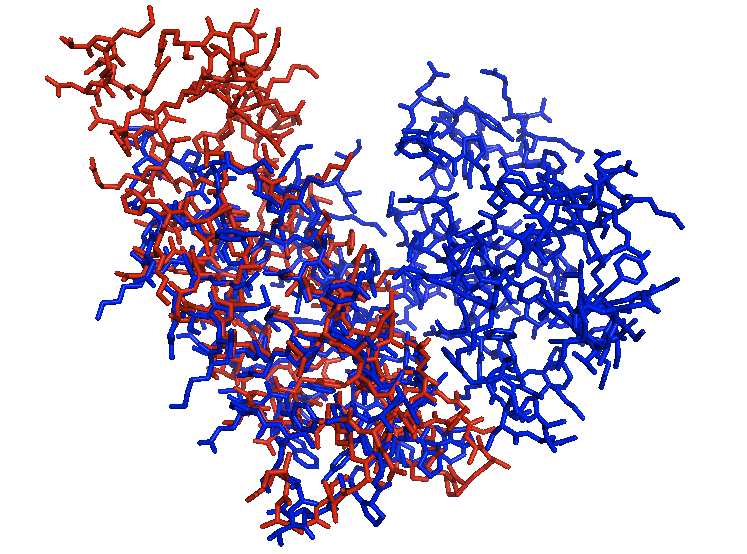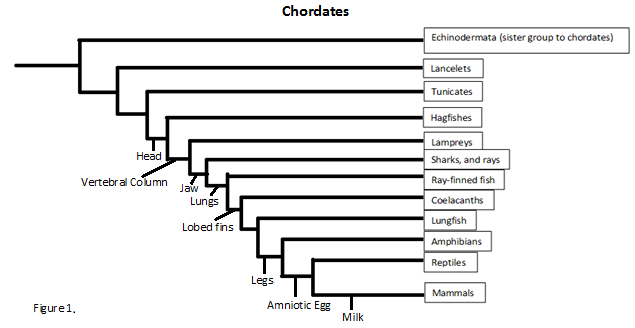User:Jonathan Lloyd/Sandbox 1
From Proteopedia
| (4 intermediate revisions not shown.) | |||
| Line 12: | Line 12: | ||
== Sequence Analysis == | == Sequence Analysis == | ||
A BLAST search of the bromodomain in ATAD2b yields many other bromodomain-containing proteins. In the table below are 8 other proteins that contain a bromodomain. Their sequences were aligned to ATAD2b using Clustal Omega and show the percent identity and similarity to ATAD2b. You can see the conserved residues throughout all the proteins (marked with *), there are 13 out of the 71 residues or 18.3%. Many of the identical residues are a result of these 13 residues showing how highly conserved they are. They have very important function in the bromodomain which is why it would be expected to see the same residues in all bromodomains. The closest protein to ATAD2b is ATAD2a which is no surprise considering they are paralogues of each other. | A BLAST search of the bromodomain in ATAD2b yields many other bromodomain-containing proteins. In the table below are 8 other proteins that contain a bromodomain. Their sequences were aligned to ATAD2b using Clustal Omega and show the percent identity and similarity to ATAD2b. You can see the conserved residues throughout all the proteins (marked with *), there are 13 out of the 71 residues or 18.3%. Many of the identical residues are a result of these 13 residues showing how highly conserved they are. They have very important function in the bromodomain which is why it would be expected to see the same residues in all bromodomains. The closest protein to ATAD2b is ATAD2a which is no surprise considering they are paralogues of each other. | ||
| + | |||
[[Image:table 1.png]] | [[Image:table 1.png]] | ||
| - | The superposition of the ATAD2b on top of ATAD2a shows us exactly how closely related they really are. There are minor differences that appear in the loop regions of random coil as the alpha helixes stay the same. When aligned with the lowest identity structure PCAF you can see the locations where they are similar but even some loop regions are not even close to each other. This tool allows you to see the location of bromodomains in other proteins and also how closely the bromodomains match each other. | + | The superposition of the ATAD2b on top of ATAD2a shows us exactly how closely related they really are. There are minor differences that appear in the loop regions of random coil as the alpha helixes stay the same. |
| + | |||
| + | [[Image:aligned01.png|Figure 4. ATAD2b in red and ATAD2a in green. Image generated using PyMol.]] | ||
| + | |||
| + | When aligned with the lowest identity structure PCAF you can see the locations where they are similar but even some loop regions are not even close to each other. This tool allows you to see the location of bromodomains in other proteins and also how closely the bromodomains match each other. | ||
| + | |||
| + | [[Image:aligned02.png|Figure 5. ATAD2b in red and PCAF in Blue. Image generated using PyMol.]] | ||
== AAA ATPase Domain == | == AAA ATPase Domain == | ||
The AAA domains share a common conserved module of approximately 230 amino acid residues. This is a large, functionally diverse protein, which exert their activity through the energy-dependent remodeling or translocation of macromolecules. Members of the AAA family are found in all organisms and they are essential for many cellular functions. They are involved in processes such as DNA replication, protein degradation, membrane fusion, microtubule severing, peroxisome biogenesis, signal transduction and the regulation of gene expression. ATP hydrolysis by AAA ATPases involves a nucleophilic attack on the ATP gamma-phosphate by an activated water molecule, leading to movement of the N-terminal and C-terminal AAA subdomains relative to each other. This movement allows the exertion of mechanical force, amplified by other ATPase domains within the same oligomeric structure. The AAA domain is part of the P-loop containing nucleoside triphosphate hydrolases superfamily which mainly consists of beta sheets. | The AAA domains share a common conserved module of approximately 230 amino acid residues. This is a large, functionally diverse protein, which exert their activity through the energy-dependent remodeling or translocation of macromolecules. Members of the AAA family are found in all organisms and they are essential for many cellular functions. They are involved in processes such as DNA replication, protein degradation, membrane fusion, microtubule severing, peroxisome biogenesis, signal transduction and the regulation of gene expression. ATP hydrolysis by AAA ATPases involves a nucleophilic attack on the ATP gamma-phosphate by an activated water molecule, leading to movement of the N-terminal and C-terminal AAA subdomains relative to each other. This movement allows the exertion of mechanical force, amplified by other ATPase domains within the same oligomeric structure. The AAA domain is part of the P-loop containing nucleoside triphosphate hydrolases superfamily which mainly consists of beta sheets. | ||
| Line 24: | Line 31: | ||
== Evolution == | == Evolution == | ||
Since we know ATAD2b can be found in such species as the Danio or zebra fish we can track the protein all the way back to the phylum chordata. This is not to say all the species under chordata can make ATAD2b but future studies would have to be conducted to find out the exact phylogenetics. But even so chordata contains many species including lancelets, lampreys, amphibians, reptiles and sea squirts. | Since we know ATAD2b can be found in such species as the Danio or zebra fish we can track the protein all the way back to the phylum chordata. This is not to say all the species under chordata can make ATAD2b but future studies would have to be conducted to find out the exact phylogenetics. But even so chordata contains many species including lancelets, lampreys, amphibians, reptiles and sea squirts. | ||
| - | [[Image:tree.png]] | + | [[Image:tree.png|Figure 6.]] |
</StructureSection> | </StructureSection> | ||
Current revision
ATAD2b
| |||||||||||
References
1)Antonina Andreeva, Dave Howorth, Cyrus Chothia, Eugene Kulesha, Alexey Murzin, SCOP2 prototype: a new approach to protein structure mining (2014) Nucl. Acid Res., 42 (D1): D310-D314.
2)Cattaneo M., Morozumi Y., Perazza D. et al. (2014). Lessons from yeast on emerging roles of the ATAD2 protein family in gene regulation and genome organization. Mol. Cells 37, 851–856.
3)Chaikuad A., Petros A.M., Fedorov O. et al. (2014). Structure-based approaches towards identification of fragments for the low-druggability ATAD2 bromodomain. Med. Chem. Commun. 5, 1843–1848.
4)Filippakopoulos P., Knapp S. (2014). Targeting bromodomains: epigenetic readers of lysine acetylation. Nat. Rev. Drug Discov. 13, 337–356.
5)Filippakopoulos P., Picaud S., Mangos M. et al. (2012). Histone recognition and large-scale structural analysis of the human bromodomain family. Cell 149, 214–231.
6)Wan W.N., Zhang Y.X., Wang X.M. et al. (2014). ATAD2 is highly expressed in ovarian carcinomas and indicates poor prognosis. Asian Pac. J. Cancer Prev. 15, 2777–2783.
7)Sanchez R., Meslamani J., Zhou M.M. (2014). The bromodomain: from epigenome reader to druggable target. Biochim. Biophys. Acta 1839, 676–685.
8)Leachman NT, Brellier F, Ferralli J, Chiquet-Ehrismann R, Tucker RP. ATAD2B is a phylogenetically conserved nuclear protein expressed during neuronal differentiation and tumorigenesis. Dev Growth Differ. 2010;52(9):747–55.
9) Yachdav, G.; Kloppmann, E.; Kajan, L.; Hecht, M.; Goldberg, T.; Hamp, T.; Hönigschmid, P.; Schafferhans, A.; Roos, M.; Bernhofer, M.; and others. PredictProtein---an open resource for online prediction of protein structural and functional features. Nucleic acids research, gku366. 2014.
